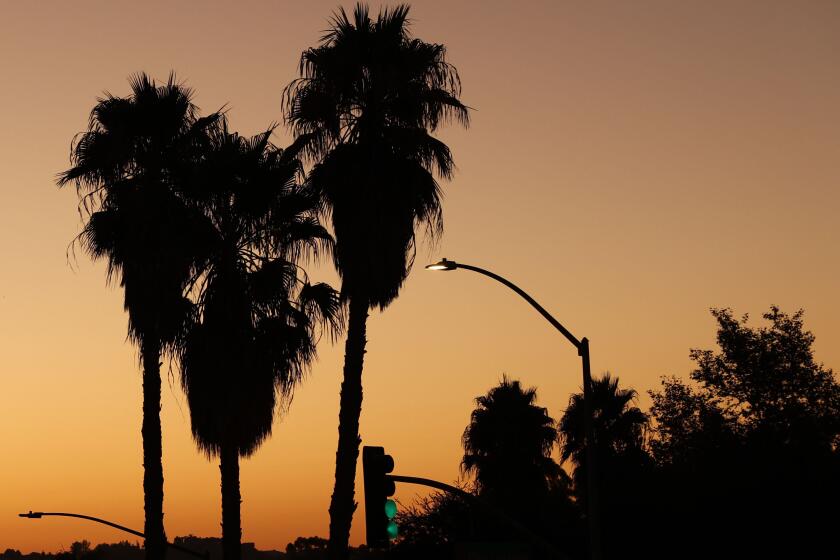California extreme weather shift: From record heat to cold, rain, even snow

- Share via
After a prolonged stretch of record-breaking heat that scorched Southern California and sparked wildfires, much of the state will experience below average temperatures, drizzle and even early-season snow this week.
The National Weather Service issued its earliest snow advisory in the past 20 years over the weekend for portions of the Sierra Nevada. In Southern California, where three fires have scorched more than 115,000 acres and burned out of control for days, the rapid cooldown and higher humidity levels have already provided some relief for firefighters trying to get a handle on the blazes.
The largest of the three, the Bridge fire in the Angeles National Forest, was 25% contained as of Monday evening, while the Line fire in San Bernardino County was 49% contained. The Airport fire, which ignited in Orange County last week and burned into Riverside County, was 31% contained as of Monday.
“This is a pretty nice temperature change and a relief after that heat wave,” said Bryan Lewis, a meteorologist with the National Weather Service in Oxnard.
The trough of low pressure, which has already dropped temperatures 5 to 10 degrees below normal in Southern California, could bring periods of light rain as early as late Tuesday night through Thursday. Parts of Los Angeles County could see less than a tenth of an inch. The foothills could see up to a quarter of an inch.
Brace yourselves, Southern Californians. A break from the heat is on its way. You just might have to wait another day, according to the National Weather Service.
Temperatures are expected to linger in the mid- to upper 60s along the coast and the low to mid-70s in the inland areas. Downtown Los Angeles, which hit 111 degrees earlier this month, is experiencing a 40-degree drop in temperatures, Lewis said.
In the Sierra Nevada, roughly 3 inches of fresh powder could fall in elevations above 8,000 feet from Fresno County to Yosemite through Monday night. And more could be on the way after that, said Antoinette Serrato, a meteorologist with the National Weather Service in Hanford.
“The low-pressure system is bringing in some pretty cold air down from the Arctic area and that’s going to bring some early snow to the region,” Serrato said.
While the cooler weather is expected to continue to aid crews, it doesn’t portend a slow fire season, experts say.
“This is a very small blip in the overall fire season,” said Robert Foxworthy, a spokesperson for the California Department of Forestry and Fire Protection. “We have ups and downs with weather as patterns shift, so the fact that we have some cool weather now and slowing fire season won’t necessarily change the total outcome of the fire season.”
The most damaging and destructive fires in Southern California typically happen October through December with the arrival of the Santa Ana winds that can help turn small fires into raging conflagrations.
Back-to-back wet winters and an arid summer have primed grasses and fine fuels for fire. The National Interagency Fire Center’s seasonal outlook, issued in August, notes a tilt in the odds toward above-normal fire potential across the Southern California coast through December due to “an increasingly likely dry fall and a delayed start to the wet season,” the outlook says.
The impending arrival of hot Santa Ana winds, combined with two years of overgrown vegetation, could pave the way for a fiery fall.
The bout of cooler weather isn’t expected to last long. California should again expect to see periods of warm and dry conditions over the next month, which could contribute to an uptick in fire activity, UCLA climate scientist Daniel Swain wrote in a recent blog post.
“Offshore wind season has yet to begin in earnest, and if/when Santa Ana or Diablo winds occur this fall, fire risk will rise accordingly (until it rains substantially). So enjoy the next 7-10 days of low wildfire risk across most of the state,” he wrote.
Firefighters battling the Airport fire, which had charred 23,519 acres as of Monday, are anticipating cooler temperatures and higher humidity will quell fire activity in the coming days.
There was 100% relative humidity overnight Sunday near the fire, which helped fire crews extend containment lines, said Orange County Fire Authority Capt. Steve Concialdi. The fire has destroyed 120 homes and three businesses.
Highway 74 remains closed, but officials lifted evacuation warnings in several areas in Riverside County and downgraded some evacuation orders to warnings.
On Sunday night windy conditions hampered the aircraft flying over the Bridge fire but crews were able to make some progress on containment. The fire had burned 54,774 acres as of Monday evening.
Firefighters are focusing mainly on the northwest portion of the blaze, which continues to be the most active, in order to protect the communities of Big Pines and Piñon Hills. On the east side, the fire is less active but still poses a risk to the Mount Baldy area, according to Cal Fire.
Crews continued to focus on the northwestern portion of the fire Monday night. The low temperatures are expected to assist firefighters in minimizing huge fire growth but the winds will create another hurdle, said L.A. County Fire spokesperson Kenichi Haskett.
On Monday evening, Cal Fire said that despite an increase in wind, firefighters and utility companies made “great progress” in restoring power and water for a safe return for Piñon Hills-area residents who were under an evacuation order.
Evacuation orders for the Forest area from Telegraph Peak east to Cucamonga Canyon, the forestry area above Shinn Road and north to Lone Pine Canyon Road were downgraded to warnings on Monday.
Fifty-four structures have been destroyed and 13 others damaged by the fire. Three people, including civilians and fire personnel, have been injured.
Los Angeles County and surrounding areas were under a red flag warning as temperatures reached more than 100 degrees in some areas.
Winds gusting up to 25 miles per hour near the Line fire in San Bernardino County helped fuel the blaze Sunday night as it continued its march through dry vegetation in the area. The blaze, which has burned 39,026 acres, destroyed one structure and damaged four others as of Monday.
In the lower elevations, firefighting conditions are expected to be more favorable because of the cooler temperatures, higher humidity levels and cloud cover. In elevations above 5,000 feet, temperatures are expected to be slightly warmer and drier. Highs are expected to be in the mid-50s, said Rick Carhart, a spokesperson for Cal Fire.
“This fire is certainly not finished yet and there’s more work to be done,” he said.
Times staff writer Melissa Gomez contributed reporting.
More to Read
Sign up for Essential California
The most important California stories and recommendations in your inbox every morning.
You may occasionally receive promotional content from the Los Angeles Times.















